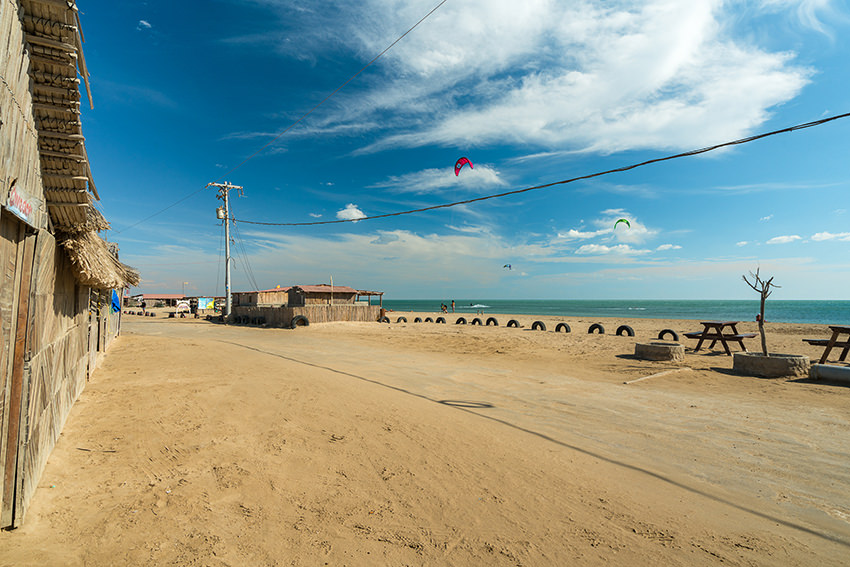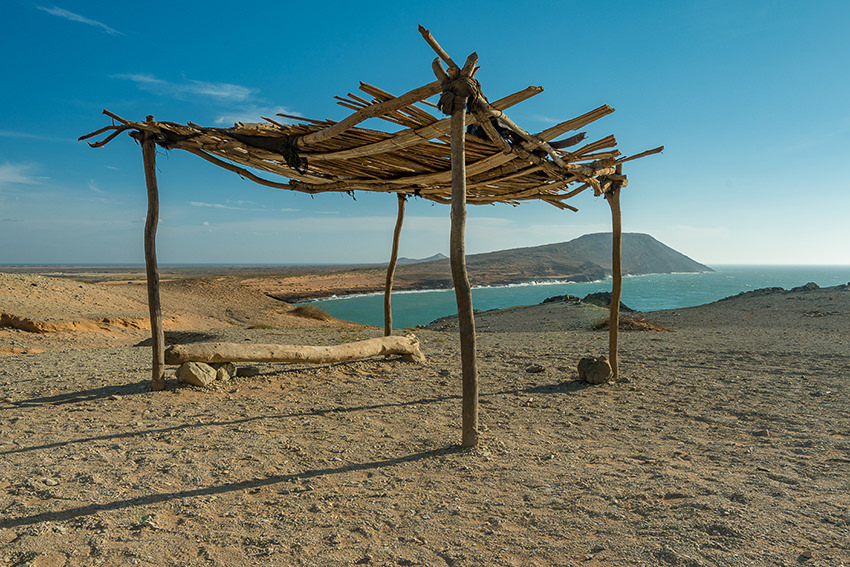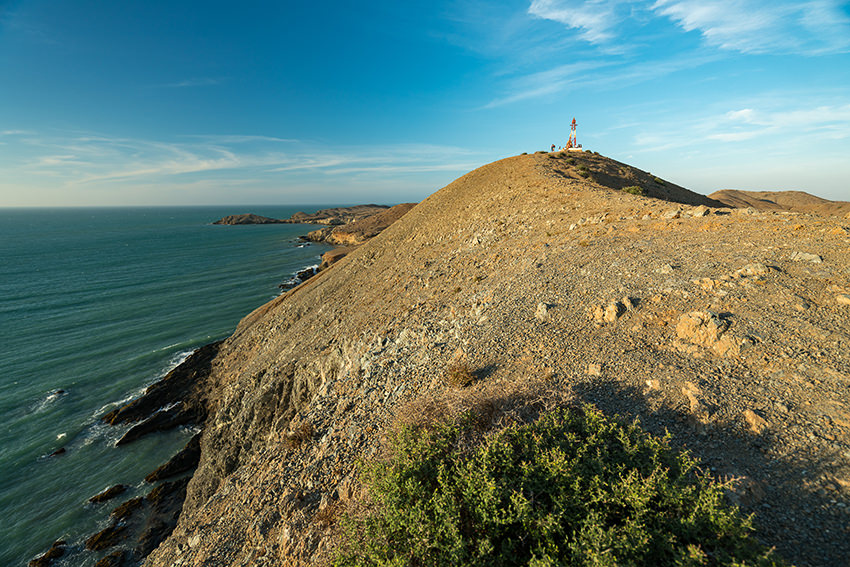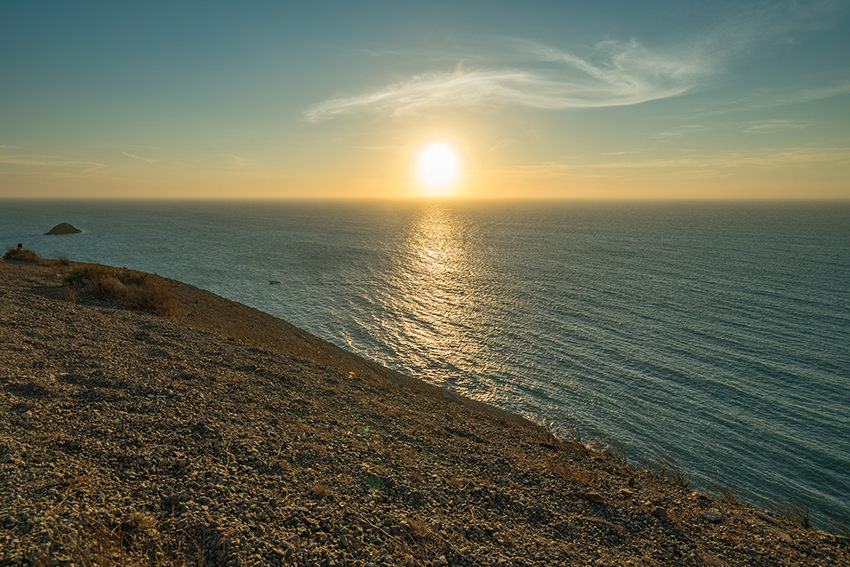
Cabo De La Vela – The Jewel Of La Guajira
Sitting in the back seat, windows down, trying to avoid eye contact with the glammed out Venezuelan girl wearing a skin tight dress, high heels, and hot pink lipstick in the middle of the desert; I was more than a little uncomfortable.
Thankfully as we rolled into Cabo de la Vela, she became infatuated with some other poor soul standing there shirtless in his kite surfing gear. I was off the hook.
I jumped out as quickly as I could, grabbed my bags, and started walking.
Cabo De La Vela
Resting along Colombia’s northern Caribbean coast; Cabo de la Vela is considered the jewel of La Guajira; the desert region that borders Venezuela. It is a small fishing village renowned for its kite surfing and for the rugged orange desert that meets the bright turquoise waters of the Caribbean.
It has done a great job of staying off of most travelers radars, but that is quickly changing. With the rise in tourism traffic to the nearby adventure destination of Punta Gallinas – South America’s most northern adventure point; Cabo de la Vela is slowly starting to become a must see part of any travel itinerary. After all, I wasn’t there just for the kite surfing.

Cabo de la Vela
Walking around the seemingly empty streets of Cabo de la Vela is a very eerie feeling. A small pharmacy and clinic are the only real signs of civilization apart from a few bars and the many kites floating high above.
If you have the time and money, I highly recommend taking some kite surfing lessons while you’re there.
A Kite Surfing Meca
High winds and calm, shallow waters make Cabo de la Vela a perfect place to learn how to kite surf. Compared to many other parts of the world, it is actually quite cheap. Many of the hostels in town cater exclusively to kite surfers, offering cheap accommodation for just a few lessons on the water.
For lessons expect to pay the following:
- One-hour – 120,000 COP or $40 USD
- Four-hours – 400,000 COP or $130 USD
- Eight-hours – 800,000 COP or $265 USD
- Ten-hours – 900,000 COP or $300 USD
The instructors have been kite surfing for most of their lives and are top notch.

Ideal Kite Surfing Conditions
If high adrenaline sports aren’t your thing, then there are some pretty amazing things still left for you to do with your time in Cabo de la Vela. The desert surrounding the town is absolutely stunning.
If you are also planning a trip to Punta Gallinas, you should have no trouble finding a tour package that includes both transportation to and from South America’s most northern point, as well as a small excursion to the areas surrounding Cabo.
Money Savings Tip – When looking for a tour, anything over 150,000 pesos is a complete rip-off. I stayed at Posada Pujuru and was able to score a trip to both Punta Gallinas as well as a tour around Cabo for 120,000 COP or $40 USD. A hammock was 20,000 COP, and a Chinchorro (a large hammock) was 25,000 COP, which was more than the other hostels, but the amount that I saved on the tour made it completely worth it.

Exploring La Guajira
If you are in La Guajira only to visit Cabo de la Vela, then instead of paying big money for a tour around the desert, you can just pay a local with a motorcycle to take you around. I recommend going to the attractions like Pinól de Azúcar and El Faro later in the afternoon.
The temperature at around 4 o’clock is much more tolerable than earlier in the day. Plus the sun at that time casts its rays perfectly over the desert landscape.

Pilón De Azúcar
Pilón De Azúcar
A great place to start your journey around La Guajira is Pilón de Azúcar. Translated to the pylon of sugar, it is a sharp peak with a small stone pillar at the very top.
Caution: The wind around this part of the desert and at the top of Pilón de Azúcar is ridiculously strong. Make sure that everything you have with you is strapped down tight.

The Pylon At The Top
The views from the top are absolutely amazing. Vast orange and yellow desert meet the deep blue sky as bright turquoise waves crash into the coastline.
I couldn’t believe my eyes. I had been deep in the jungle on the same Caribbean coast for over a month, and I couldn’t have imagined that same coastline turning into this.
Was I still in Colombia?

Is this still Colombia?
I find the longer that I travel, the harder it’s becoming to see something that I haven’t already seen before. Don’t get me wrong, I love any kind of adventure, even if it is similar to something I’ve already done.
It’s just that, when I experience something new, it has a way of completely renewing my wanderlust for the world. It has been almost a month since my trip to Cabo de la Vela, and I am still riding the high of the experience.

The Bay of Pilón de Azúcar

El Faro – The Lighthouse
El Faro

Not A Bad Looking Pile Of Rocks
Sitting there watching the sun sink into the ocean was such a relaxing experience. There will most likely be loads of other travelers sitting there waiting on the best show in town, and it will probably get pretty loud.
If you just walk down the hill a bit, you will have space all to yourself. Completely void of any noise or distractions.

A Beautiful Caribbean Sunset
High winds, although often times annoying, can be a godsend when it comes to making a beautiful sunset. The strong gusts kick up tons of dust, which the dying rays of light catch; turning the sky into a pastel painting of blues and pinks.
The sun setting over the ocean isn’t the only work of beauty happening that time of day. Make sure to hike to the backside of El Faro before the light completely dies out. The hills and desert being lit up is something you won’t want to miss.

A Perfect End To A Perfect Day
After the sun sets, or better yet, just before; it is a good idea to try and beat the crowds down to the cars and bikes waiting at the bottom of the hill. If you get there too late you might end up standing there waiting for them to return or even worse, be crammed ten deep into a vehicle that only fits five.
Hiring a motorcycle should cost only 5,000 COP or $1.65 USD, and it’s a blast thrashing through the desert like you’re in a scene out of the movie Mad Max.
Getting To Cabo De La Vela
The city of Uribia is the main gateway to the La Guajira region. There are both expensive and cheap ways of getting there.
From Santa Marta –
Option 1: Take a bus to Riohacha and then from there, a Colectivo to Uribia for 15,000 COP or $5 USD.
Option 2: Take a bus directly to Cuatro Vias (4-way intersection) for 25,000 COP or $8.40 USD. From there hire a 4×4 to Cabo de la Vela for 20,000 COP. Beware of high initial offers; take your time and barter down.
From Riohacha – Take a Colectivo to Uribia for 15,000 COP or $5 USD.
Once you are in Uribia, hire a 4×4 to take you to Cabo de la Vela. The driver will drop you off wherever you need, however, most of the time they will insist that you stay at their family members hostel. Just politely decline.
What To Bring To Cabo De La Vela
Cabo de la Vela is very remote; meaning the only means of supplies comes by way of 4×4 vehicles. Food, water, and any other basic item are hard to come by, and when you do find them, they are costly.
Warning: There are no ATM’s in Cabo, and the closest cash point is in Uribia so make sure to bring at least a few hundred thousand Colombian pesos to cover yourself. Also, bring more depending if you are taking kite surfing lessons or going to Punta Gallinas.
I recommend bringing as much water and snacks as you can manage. You will save a ton of money, and you will be sitting in a vehicle the whole time, so you don’t have to worry about it being too heavy.
★ Check out my backpacking checklist, with links to all of the gear that keeps me on the road and ready for any adventure.


What a beautiful place! Colombia seems to have many different terrains to explore. Thanks for sharing.